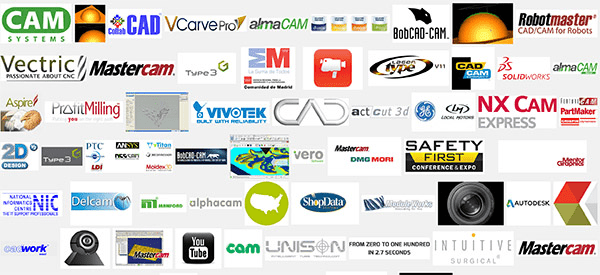
This year, we had over 400 responses to the CNCCookbook 2020 CAM Survey. Last year it was about 300 responses. The results are always fascinating. As before, I will publish the full results in an eBook that is only available to loyal CNCCookbook readers. In other words, you must be subscribed to our blog newsletter to receive it.
Sign up here to start receiving our weekly CNC Blog Newsletter, and to make sure you receive your copy of the full survey results, which will come in the form of an eBook:
Email *
That eBook will provide a detailed breakdown including information such as:
- Comparison of all results versus last year’s survey so you can see market trends.
- Detailed market segmentation by High End, Tiered Software, and Low End products.
- Individual package market share by segment.
- CAM market share for CNC Router users.
- Overall market share.
- Market share of types of CNC Work being done including Milling, Turning, Router, EDM, Industrial Robots, and more.
- Conversational Programming trends
- What types of post-CAM g-code customization users are doing
- How CNC’ers are testing their CAM-generated part programs
And much more. You'll receive the eBook via email as soon as it is available. There's still more data to be crunched, so it'll be a few more days.
Meanwhile, here is the big picture-overall 2020 CAM Market Share:
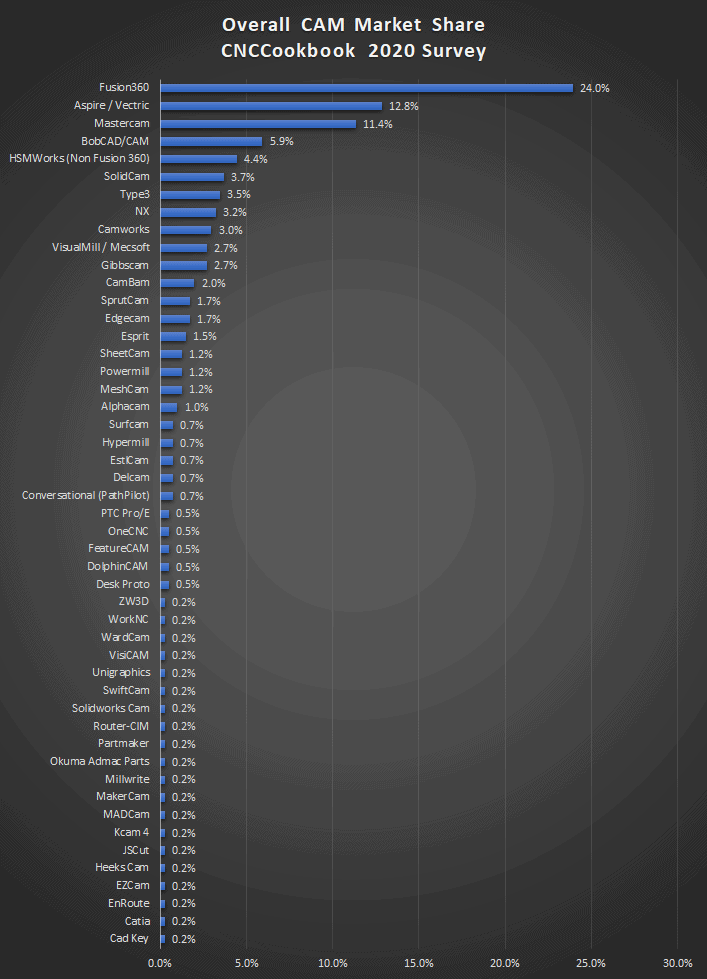
As you can see, the big three are Fusion 360, Aspire/Vectric (the whole Vectric product line as a group), and Mastercam.
Customer Satisfaction Awards Winners
Which packages did customers love the most? There’s a lot more detail in the eBook, but here are the winners:
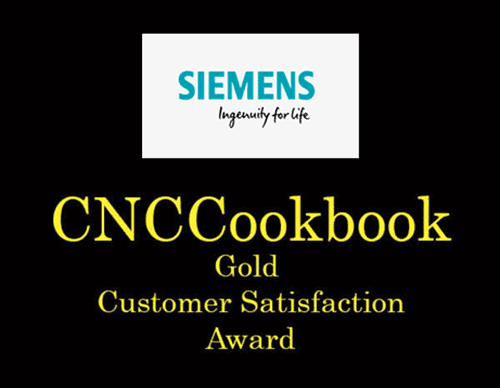
Siemens NX took top honors for customer satisfaction with a score of 1.79 out of a possible 2.0. Congratulations to the NX team!
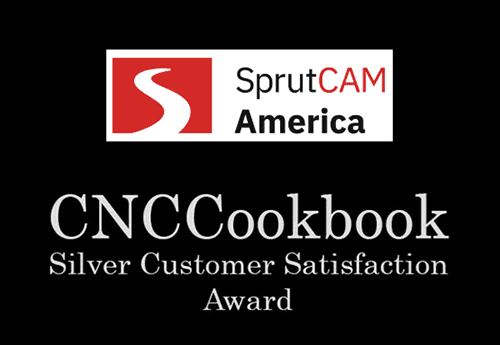
Our silver award goes to SprutCAM, which received a score of 1.57. Congrats to the SprutCAM team!
CamBam came in third with a score of 1.50.
How to Build Your CAM Package Short List
We’ve delivered a lot of the ingredients you’ll need to put together your short list in our eBook:
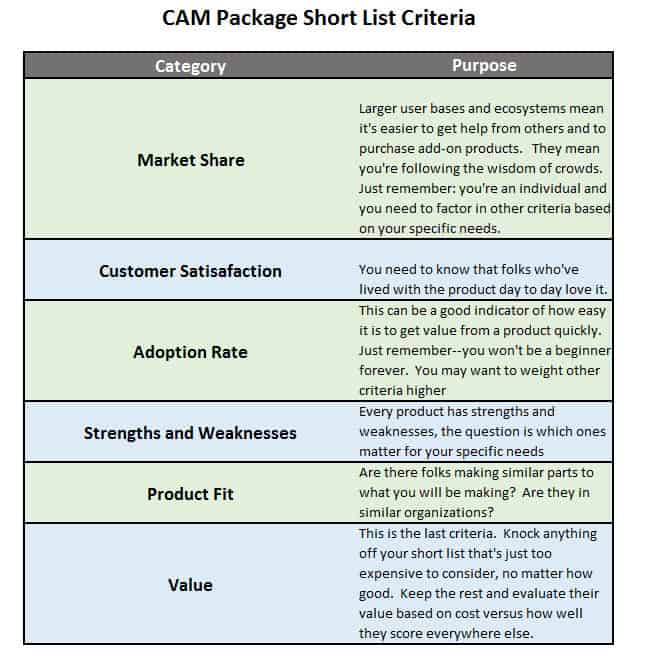
Let’s go over each category of information and talk about why it matters and how you can research it.
Market Share
We always want to understand how popular things are before we adopt them–it’s human nature. We’re hardwired to care about it for very good reasons–popularity is a good proxy for some very important things. It harnesses the wisdom of crowds in your favor. Popularity gives you insight into the hard work others before you did evaluating products.
But, be careful!
You’re an individual with specific needs. Popularity is far from everything. There are popular packages that you might find terrible for your needs, and less well-known packages that might be just perfect for you.
All I’m saying is popularity can only be one of the dimensions you consider.
Popularity is also important because it goes to the size of the community and ecosystem that are behind a product. Popular products are easier to find help for. There are more people you can ask. More people with experience who can help or even be hired by you. There will be more add-on products, training, and other resources to choose from.
Determining popularity used to be hard. People paid a fortune to market researchers to buy their proprietary reports. CNCCookbook changed all that by giving away such results in the form of our surveys. We cover a huge part of the market–four and a half million visits a year to our web site and hundreds of participants in the surveys.
Customer Satisfaction
This one is important–it tells you what the people who’ve lived with the product day to day really think. These are the folks that eventually did master the product, not just the looky loos and the people who have an opinion about everything.
Here again, this used to be hard to find anything about. But, CNCCookbook is now giving annual customer satisfaction awards to CAM Software vendors and you get to see who they are. Take full advantage of that information as you’re building your short lists. Give extra weight to those products whose customers are particularly enthusiastic about them and be a little more skeptical of others.
Don’t just take our survey’s word for it either. Once you have narrowed your list a bit, go visit the online community for the software. If they won’t let you in before you buy, go to online communities you have access to that talk about the product. Check into the following:
- Common complaints
- Seriously unhappy customers and what their story is. It’s okay if there are a few, but do the other participants try to support the product and suggest their experiences were better, or do they just kind of stand back? The best products will have fans that come to the rescue when others are running it down.
- Passion: Are their folks extolling the virtues of using the software?
You get the idea of what to look for. This kind of research is easy to do in our digital world and very valuable.
Make sure a few of the winners land on your short list.
Adoption Rate
We just covered adoption rates. My primary thought is to use them as a way to understand how easy it is to realize the value of a product during the evaluation. That doesn’t mean products with lower adoption rates can’t be valuable–it just means you’ll have to work harder or learn more than people do during an evaluation to get there.
It’s like the difference between ease of learning and ease of use. These are not the same thing if you think about it. Ease of Learning is how easy it is for a beginner to get started using the product while ease of use is how easy for someone who knows the product to be productive with it.
Strengths and Weaknesses
CAM Software, like a lot of other things, is not really one-size-fits all. Your needs may not be the same as the next CNC’ers needs. We can approach this in a couple of ways. The first thing to check out are the product’s strengths and weaknesses.
Try to compare the Strengths and Weaknesses to your needs. If you don’t plan to run 5-axis any time soon, it’s probably not an issue if this is not a strength. On the other hand, if you are going to be making complex parts and you need to save every last penny, you probably want a package that’s strong on toolpaths.
Product Fit
Is a gauge of similarity to what others are doing. Do the same kind of online community research I described under Customer Satisfaction. This time you’re looking for:
- Photos, stories, and examples of parts and projects made with the product that are similar to what you want to do.
- Get a feel for the audience–are they people like you? Radically different? Can you relate to what they have to say?
These are all clues about how good a fit this product might be for you.
Value
This should be the last thing you research, and not necessarily the first. I am very deliberate in choosing the word “Value” over “Price.” A cheap product may be worthless if it doesn’t solve your problem, or if it makes it so hard that you more than offset any savings with frustration and extra time spent.
You have some idea of your budget, so knock out the products that are clearly way out of bounds first. After that, you’ll be focusing on value rather than price. Value is defined roughly as Utility divided by Price. You might be willing to pay twice as much for something that is twice as useful, or at least you’re more likely to consider the higher price. For two products of roughly the same utility, why pay more?
You can see why Value has to be considered last–all of the other dimensions are put together using a weighting scheme to arrive at the Utility for the package to you.
Let’s use a sample Excel worksheet to quantify how that might work.
A worksheet for building your CAM Software Short List
Go ahead and click this link to download an Excel worksheet you can use as a template to create your CAM Software Short List. It looks like this:
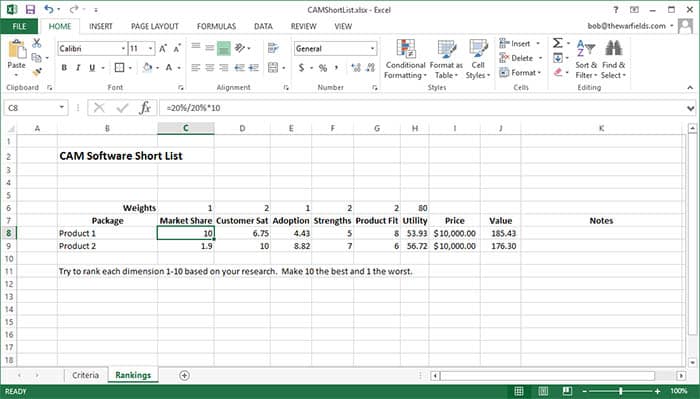
You can see there are columns representing each dimension–Market Share, Customer Sat, etc.. The goal is to rate each package on a scale of 1 to 10 for each dimension. Make sure 10 is the best and 1 is the worst so we have apples to apples.
Notice how there are numbers above the dimensions and they’re labelled, “Weights.” This allows you to weight each dimension as you like. Ignore the numbers there, they’re just hypotheticals. Enter whatever you like for the weights, but leave the value above Utility alone. It represents the highest utility score any package can get if every dimension scored a perfect “10”.
That’s right–Utility aggregates the weighted scores to create an overall utility score for each package. We then take the price, divide by the Utility, and arrive at Value. It’s sort of a $ per utility rate, so smaller Values are better.
When you have everything filled out, sort in descending order of value. Take the top 2 or 3 packages and evaluate them fully to see who the real winners are.
As far as individual formulas for the dimension ratings, you either eyeball it as I did with Product Fit, or try to create more quantitative metrics.
For example, on Market Share, I took the largest market share (20%), and scaled 1 to 10 based on how large a share this package had. This is based on the Market Share values from our survey. On Customer Sat, I took a theoretical perfect 2.0 score, figured what percent the sat was from CNCCookbook’s surveys, and scaled that to a 1..10 value.
There’s no point in getting to crazy and analytical about what are in the end of the day somewhat subjective numbers, but it can help to be a little rigorous in converting them to your 1 to 10 ratings.
If you create a worksheet like this, it can really help you narrow your choices in an educated way to a small number of packages which you’ll then do a full evaluation on.
What are you thoughts on how to create the best short list of packages to evaluate? Tell us in the comments.
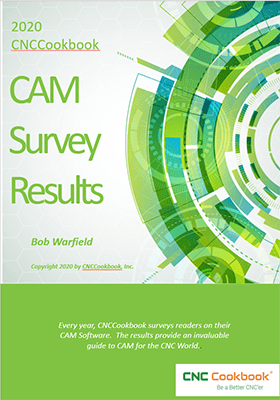
PS As I mentioned, much more information is available in our eBook, so be sure to use the signup above to join our email newsletter if you haven't already.
Be the first to know about updates at CNC Cookbook
Join our newsletter to get updates on what's next at CNC Cookbook.